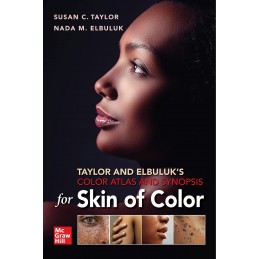- Reduced price

Order to parcel locker

easy pay


 Delivery policy
Delivery policy
Choose Paczkomat Inpost, Orlen Paczka, DHL, DPD or Poczta Polska. Click for more details
 Security policy
Security policy
Pay with a quick bank transfer, payment card or cash on delivery. Click for more details
 Return policy
Return policy
If you are a consumer, you can return the goods within 14 days. Click for more details
The expert guide to identifying and understanding the clinical differences of common dermatology conditions in patients of all skin types
An essential component of dermatology training is the accurate identification of skin diseases in all patients. Taylor and Elbuluks Color Atlas and Synopsis for Skin of Color is designed to help you recognize the differences in disease presentation amongst patients with lighter and darker skin, thus improving diagnostic accuracy and lessening the burden of disease for patients of color.
More than 350 color images illustrate the variances in the appearance of common dermatology conditions between Fitzpatricks Skin Type I-III lighter skin types and Fitzpatricks Skin Type IV-VI darker skin types. This is an invaluable tool for providing optimal care to patients of all skin types—and an ideal resource for medical students, residents, attending physicians, and other healthcare providers.
Taylor and Elbuluks Color Atlas and Synopsis for Skin of Color covers::
Data sheet
Inflammatory and Papulosquamous Disorders
Atopic Dermatitis Morphological types
Papular eczema
Follicular accentuation
Dyschromia
Lichenification
Pityriasis alba
Psoriasis
Morphology and color (violaceous and hyperpigmented with lichenification vs erythematous and devoid of silvery white scale)
Contact Dermatitis
Morpholology and color (hyperpigmentation vs erythema vs LPP-like in South Asian population)
Pityriasis Lichenoides Chronica
Morphology and color (hypopigmented patches or vitilgo like in darker skin vs erythematous guttate papular appearance in light skin)
Pityriasis Rosea
Morphology and color (similar distribution hyperpigmented to violeceous vs. erythematous; papular variant)
Seborrheic Dermatitis
a Facial Morphology and color (petaloid seborrheic dermatitis and hypopigmentation vs erythema)
b. Scalp - Morphology and color (more scale vs sebopsoriasis like in lighter skin)
Lichen Planus
Morphology and color (similar morphology except hypertrophic LP darker violet or brown to black vs bright violet in lighter skin)
Reference: 72960
Author: Pravin Jaiprakash Gupta
Reference: 95952
Author: Biju Vasudevan
